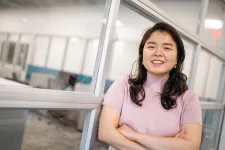(Press-News.org) An artificial intelligence computer program that processes magnetic resonance imaging (MRI) can accurately identify changes in brain structure that result from repeated head injury, a new study in student athletes shows. These variations have not been captured by other traditional medical images such as computerized tomography (CT) scans. The new technology, researchers say, may help design new diagnostic tools to better understand subtle brain injuries that accumulate over time.
Experts have long known about potential risks of concussion among young athletes, particularly for those who play high-contact sports such as football, hockey, and soccer. Evidence is now mounting that repeated head impacts, even if they at first appear mild, may add up over many years and lead to cognitive loss. While advanced MRI identifies microscopic changes in brain structure that result from head trauma, researchers say the scans produce vast amounts of data that is difficult to navigate.
Led by researchers in the Department of Radiology at NYU Grossman School of Medicine, the new study showed for the first time that the new tool, using an AI technique called machine learning, could accurately distinguish between the brains of male athletes who played contact sports like football versus noncontact sports like track and field. The results linked repeated head impacts with tiny, structural changes in the brains of contact-sport athletes who had not been diagnosed with a concussion.
“Our findings uncover meaningful differences between the brains of athletes who play contact sports compared to those who compete in noncontact sports,” said study senior author and neuroradiologist Yvonne Lui, MD. “Since we expect these groups to have similar brain structure, these results suggest that there may be a risk in choosing one sport over another,” adds Lui, a professor and vice chair for research in the Department of Radiology at NYU Langone Health.
Lui adds that beyond spotting potential damage, the machine-learning technique used in their investigation may also help experts to better understand the underlying mechanisms behind brain injury.
The new study, which published online May 22 in The Neuroradiology Journal, involved hundreds of brain images from 36 contact-sport college athletes (mostly football players) and 45 noncontact-sport college athletes (mostly runners and baseball players). The work was meant to clearly link changes detected by the AI tool in the brain scans of football players to head impacts. It builds on a previous study that had identified brain-structure differences in football players, comparing those with and without concussions to athletes who competed in noncontact sports.
For the investigation, the researchers analyzed MRI scans from 81 male athletes taken between 2016 through 2018, none of whom had a known diagnosis of concussion within that time period. Contact-sport athletes played football, lacrosse, and soccer, while noncontact-sport athletes participated in baseball, basketball, track and field, and cross-country.
As part of their analysis, the research team designed statistical techniques that gave their computer program the ability to “learn” how to predict exposure to repeated head impacts using mathematical models. These were based on data examples fed into them, with the program getting “smarter” as the amount of training data grew.
The study team trained the program to identify unusual features in brain tissue and distinguish between athletes with and without repeated exposure to head injuries based on these factors. They also ranked how useful each feature was for detecting damage to help uncover which of the many MRI metrics might contribute most to diagnoses.
Two metrics most accurately flagged structural changes that resulted from head injury, say the authors. The first, mean diffusivity, measures how easily water can move through brain tissue and is often used to spot strokes on MRI scans. The second, mean kurtosis, examines the complexity of brain-tissue structure and can indicate changes in the parts of the brain involved in learning, memory, and emotions.
“Our results highlight the power of artificial intelligence to help us see things that we could not see before, particularly ‘invisible injuries’ that do not show up on conventional MRI scans,” said study lead author Junbo Chen, MS, a doctoral candidate at NYU Tandon School of Engineering. “This method may provide an important diagnostic tool not only for concussion, but also for detecting the damage that stems from subtler and more frequent head impacts.”
Chen adds that the study team next plans to explore the use of their machine-learning technique for examining head injury in female athletes.
Funding for the study was provided by National Institute of Health grants P41EB017183 and C63000NYUPG118117. Further funding was provided by Department of Defense grant W81XWH2010699.
In addition to Lui and Chen, other NYU researchers involved in the study were Sohae Chung, PhD; Tianhao Li, MS; Els Fieremans, PhD; Dmitry Novikov, PhD; and Yao Wang, PhD.
Media Inquiries:
Shira Polan
Phone: 212-404-4279
shira.polan@nyulangone.org
END
New tool may help spot “invisible” brain damage in college athletes
2023-05-30
ELSE PRESS RELEASES FROM THIS DATE:
The next generation of solar energy collectors could be rocks
2023-05-30
The next generation of sustainable energy technology might be built from some low-tech materials: rocks and the sun. Using a new approach known as concentrated solar power, heat from the sun is stored then used to dry foods or create electricity. A team reporting in ACS Omega has found that certain soapstone and granite samples from Tanzania are well suited for storing this solar heat, featuring high energy densities and stability even at high temperatures.
Energy is often stored in large batteries when not needed, but these can be expensive and require lots of resources to manufacture. A lower-tech alternative ...
Hidden in plain sight: Windshield washer fluid is an unexpected emission source
2023-05-30
Exhaust fumes probably come to mind when considering vehicle emissions, but they aren’t the only source of pollutants released by a daily commute. In a recent ACS’ Environmental Science & Technology study, researchers report that alcohols in windshield washer fluid account for a larger fraction of real-world vehicle emissions than previous estimates have suggested. Notably, the levels of these non-fuel-derived gases will likely remain unchanged, even as more drivers transition from gas-powered ...
Humans evolved to walk with an extra spring in our step
2023-05-30
A new study has shown that humans may have evolved a spring-like arch to help us walk on two feet. Researchers studying the evolution of bipedal walking have long assumed that the raised arch of the foot helps us walk by acting as a lever which propels the body forward. But a global team of scientists have now found that the recoil of the flexible arch repositions the ankle upright for more effective walking. The effects in running are greater, which suggests that the ability to run efficiently could have been a selective pressure for a flexible arch that made walking more efficient too. This discovery could even help doctors improve ...
Bile acid receptor could be innovative target in protecting the vision of premature newborns
2023-05-30
AUGUSTA, Ga. (May 30, 2023) – It sounds like bile acid in the eye would hurt, but scientists think stimulating one of its receptors can actually help protect the vision of premature newborns.
It’s called the farnesoid-X-receptor, or FXR, a bile acid receptor whose expression is significantly diminished in two key cell types affected by retinopathy of prematurity.
Medical College of Georgia scientists have early evidence that targeting that receptor could provide earlier, more impactful treatments for these babies, a process that could be expedited by the fact that the drugs they ...
Study finds similar quality and cost of care for patients treated by an allopathic (M.D.) or osteopathic (D.O.) physician
2023-05-29
1. Study finds similar quality and cost of care for patients treated by an allopathic (M.D.) or osteopathic (D.O.) physician
Abstract: https://www.acpjournals.org/doi/10.7326/M22-3723
Editorial: https://www.acpjournals.org/doi/10.7326/M23-1165
URL goes live when the embargo lifts
An observational study of more than 329,000 Medicare admissions found that older persons receiving hospital care from an allopathic (M.D.) or an osteopathic (D.O.) physician experience similar quality and cost of care. The findings are published in Annals ...
UCLA-led research suggests no difference in health outcomes, care costs for patients treated by traditional MDs or osteopaths
2023-05-29
New UCLA-led research suggests that patient mortality rates, readmissions, length of stay, and health care spending were virtually identical for elderly hospitalized patients who were treated by physicians with Doctor of Medicine (MD) or Doctor of Osteopathic Medicine (DO) degrees.
While both traditional, or allopathic, medical schools and osteopathic medical schools provide the same rigorous health education, osteopathic training adds a more holistic, hands-on component involving manipulation of the musculoskeletal system – for ...
Low-flavanol diet drives age-related memory loss, large study finds
2023-05-29
May 29, 2023--A large-scale study led by researchers at Columbia and Brigham and Women’s Hospital/Harvard is the first to establish that a diet low in flavanols—nutrients found in certain fruits and vegetables—drives age-related memory loss.
The study found that flavanol intake among older adults tracks with scores on tests designed to detect memory loss due to normal aging and that replenishing these bioactive dietary components in mildly flavanol-deficient adults over age 60 improves performance on these tests.
“The improvement among study participants with low-flavanol diets was substantial and ...
Vehicle stop study illuminates importance of officer's first words
2023-05-29
Eugenia Rho believes in the importance of first impressions, especially during vehicle stops.
An assistant professor in the Department of Computer Science, Rho is the lead author of a new research paper that illustrates how a law enforcement officer’s first 45 words during a vehicle stop with a Black driver can often indicate how the stop will end.
“We found that there’s a key difference in how officers talk to Black drivers during the first moments of stops that end in an arrest, handcuffing, or search versus those that don’t end in such outcomes,” said Rho, who leads the Society, AI, and Language (SAIL) ...
Eliminating gene SRC-3 in immune cells triggers effective long-lasting anti-cancer response
2023-05-29
Researchers at Baylor College of Medicine have discovered a crucial regulator of the anti-cancer immune response that could change the game in the fight against cancer. Published in the Proceedings of the National Academy of Sciences, the study shows that in animal models of breast and prostate cancer, eliminating the gene SRC-3, specifically in a type of immune cell called regulatory T cells (Tregs), triggered a lifelong anti-cancer response that eradicated the tumor without the typical side effects observed with other therapies.
Furthermore, transferring Tregs without SRC-3 to animals carrying breast cancer ...
Even lawyers don’t like legalese
2023-05-29
CAMBRIDGE, MA -- It’s no secret that legal documents are notoriously difficult to understand, causing headaches for anyone who has had to apply for a mortgage or review any other kind of contract. A new MIT study reveals that the lawyers who produce these documents don’t like them very much either.
The researchers found that while lawyers can interpret and recall information from legal documents better than nonlawyers, it’s still easier for them to understand the same documents when translated into “plain English.” Lawyers also rated plain ...


